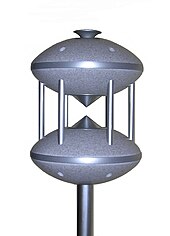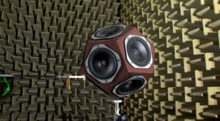Omnidirectional loudspeaker
An omnidirectional loudspeaker (also called radial radiator or all-round radiator ) is understood to be a sound-generating system which, in contrast to conventional loudspeaker types, hardly emits its sound energy in a directional manner , i.e. ideally radiates evenly in a spherical shape.
In most cases, it is a loudspeaker box in which individual components ensure that the sound from their loudspeakers is distributed horizontally in a circle. However, there are also loudspeakers that emit multidirectional themselves.
technical basics
The degree of sound bundling depends on the sound frequency and the area of the loudspeaker. Conventional woofers, for example, radiate sound almost spherically below around 150 Hz . With tweeters, on the other hand, most of the reproduced wavelengths are smaller than the front panel: This means that they are reflected and bundled towards the front. (The transition to the acoustic half-space is known as the baffle step in loudspeaker construction .) The degree of bundling is subject to various recommendations in the recording studio. It should not be too small.
Goal setting and limits
Even omnidirectional loudspeakers cannot solve the basic problem of hi-fi reproduction: The design of the reproduction begins with the recording, but at the latest with the mixing of the sound material in the studio. A copy of the original sound field into the listening room is generally not possible. All formats that have been commercialized so far are subject to strong, very fundamental restrictions. That is why the sound image created by the sound engineer in the studio in a creative process should be regarded as "good and correct", as the original. Accordingly, the loudspeaker system in the studio is also the benchmark for faithful reproduction.
In many cases, however, the consumers of the sound recording are less interested in a reproduction that is actually true to the original, which requires them to adhere to certain procedures. In particular, the limitations of the stereo format - for example because of the systemic “sweet spot” known as “you have to sit right in the middle” - can distract attention.
A strongly dispersed reproduction by omnidirectional loudspeakers then clearly contradicts the studio standards. However, it blurs the errors that occur in the stereo process when the listener no longer wants to follow the rules. Mainly criteria such as "image sharpness" are given up. A voice mixed roughly in the middle usually quickly tips to one side when leaving the stereo triangle. In the omnidirectional case, it would on the one hand appear rather diffuse in the room in the stereo triangle, but it also remains there when the “sweet spot” is left.
The reverb component present in the recording is covered more strongly during playback. Because the boundary surfaces of the listening room reflect the sound - in different forms, depending on their distance and their damping properties . The more the listening room reverberation overlays the corresponding information of the original signal, the more it falsifies the feeling of space, as it was set as correct in the recording studio.
The reflections in the listening room can also change the sound balance. Frequency ranges are emphasized or weakened depending on the design of the all-round radiation, in conjunction with the interior fittings, the installation and the listening position. Such problems also occur with conventional loudspeakers, but more so with omnidirectional speakers. Especially because it makes little sense to set it up in familiar positions, for example on a shelf.
Omnidirectional loudspeakers are therefore preferred in large, rather poorly furnished rooms. With modern techniques in the recording studio, such as digital, often amplified reverb components, and the use of ever smaller, thus intrinsically round radiating loudspeakers, the importance of special designs is receding.
Designs
The theoretically simplest case is with a point-shaped sound source that vibrates freely and evenly in all directions. On the other hand, loudspeakers and loudspeaker boxes shine in all directions anyway, not least because of diffraction effects . Only the volume decreases, strictly proportional to the size of the loudspeaker outside the directional axis, with increasing frequency. In practice in the field of home audio, the construction of loudspeakers generally focuses on the listening level, i.e. the horizontal as defined by the stereo method and derived methods.
Omnidirectional speakers
The only transducer that comes close to a spherical emitter is the plasma tweeter : an air plasma is generated between two contacts by means of high voltage , which oscillates in time with the signal. Only the parts of the construction that are “in the way” limit its almost spherical radiation behavior.
The radial radiators from MBL are based on circularly arranged, outwardly curved lamellae, which are set in motion by vertical compression .
The construction of the bending wave converters from German Physiks is similar to cone loudspeakers. However, the membrane is clearly elongated and the chassis is installed horizontally. From the outside you can see what is the back of the cone in conventional loudspeakers - and this hardly moves in the shape of a piston, but rather oscillates due to deformation.
Housing with diffuser elements
In this widespread design, “normal” loudspeakers are mounted horizontally. The sound emanating from the membrane is deflected by housing elements and reflected sideways in a circle. Mostly it is a simple, straight cone with a 90 ° opening angle and a base area similar to the effective diaphragm diameter; however, a vertical horn that radiates sideways can also be used.
There are also constructions with speakers radiating mirror-image "against each other", the sound waves of which are deflected sideways in a circle by the housing and the two membrane cones controlled in phase.
Dipoles and Bipoles
Loudspeaker diaphragms emit a similar amount of sound energy on the rear side as on the front - but out of phase , which can lead to an acoustic short circuit when operated without a housing . Nevertheless, some speakers use this sound component equally: For example, many magnetostats , but also tweeter constructions in which a second transducer works in antiphase at the rear. The subjective impression of a “spacious” sound pattern of such dipoles results, similar to that of all-round radiators, from the increased inclusion of room reflections.
Bipoles are sometimes used as the rear sound sources of surround systems (also called effect loudspeakers): boxes with opposite, but in-phase speakers, which ensure a diffuse sound.
Housing with offset speakers
The theory of omnidirectional radiation is also followed by the model of the smallest possible sphere, which is equipped with as many loudspeakers as possible. In practice, however, only several loudspeakers that cover the same frequency range are currently installed in other walls of the box in addition to the front. Such systems (under names like “3D loudspeakers” in the trade) produce something like “spatial sound”; However, time differences and comb filter effects impair precise playback.
Corresponding loudspeaker systems are particularly important in building and room acoustics measurement technology. Here systems with twelve individual speakers ( dodecahedron ) are usually used , and more rarely with eight ( octahedron ) or twenty ( icosahedron ) speakers. However, the focus is not so much on the sound , but rather on an even distribution of the sound energy in all radiation directions. In addition, corresponding test speakers are designed for the measuring range required for standard measurements, which is why the lower limit frequency is usually just below the thirds of 100 to 50 Hz. Since the corresponding measurements are always locally averaged, the directional dependency caused by the superimposition of the individual sound fields is hardly significant at higher frequencies.
literature
- G. Schwamkrug, R. Römer: Loudspeaker - Poetry and Truth . Elektor Verlag, Aachen 1986, ISBN 3-921608-45-7 .
- Hans Herbert Klinger: Loudspeakers and loudspeaker housings for HiFi . Franzis' Verlag, Munich 1981, ISBN 3-7723-1051-6 .
Individual evidence
- ↑ Product description (PDF) on the homepage of the manufacturer
- ↑ Test report (PDF; 13.4 MB) in the magazine stereoplay , issue 9, 2010.
- ↑ Example: Patent No. EP 0667730 B1


